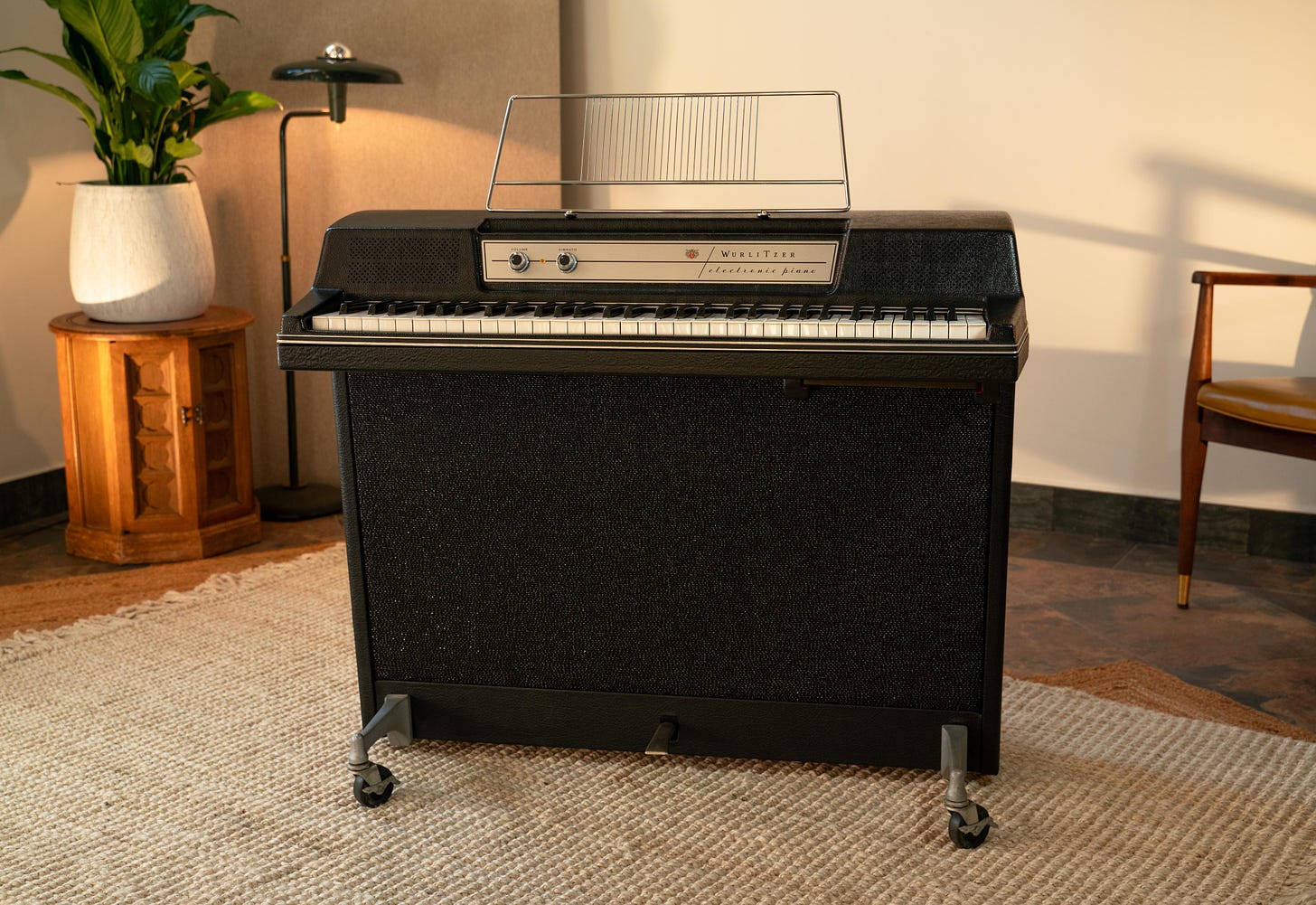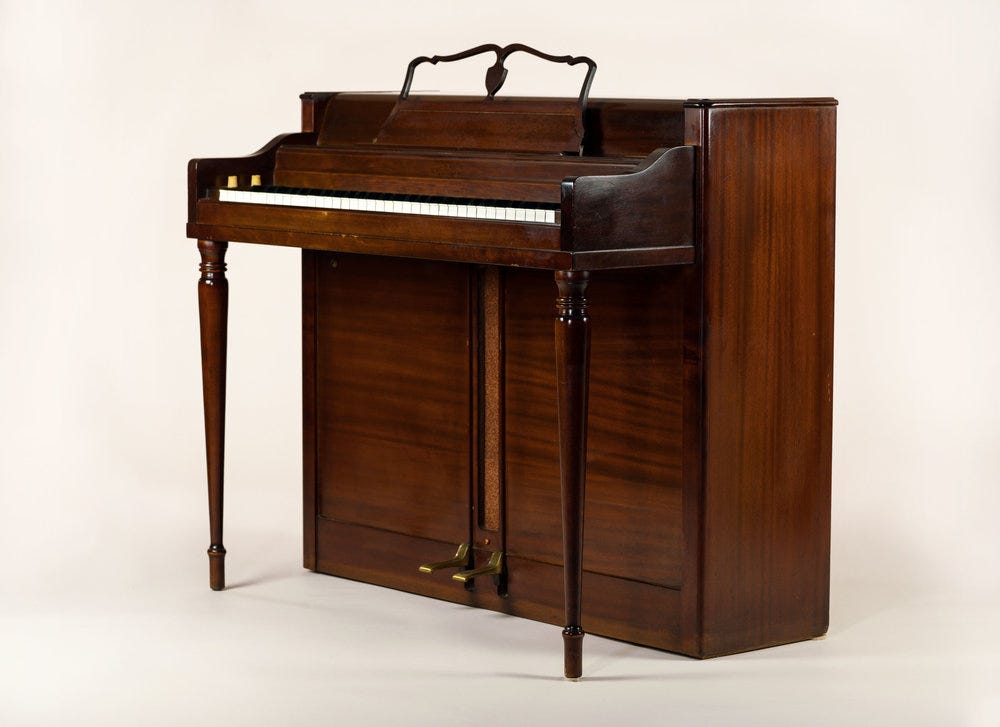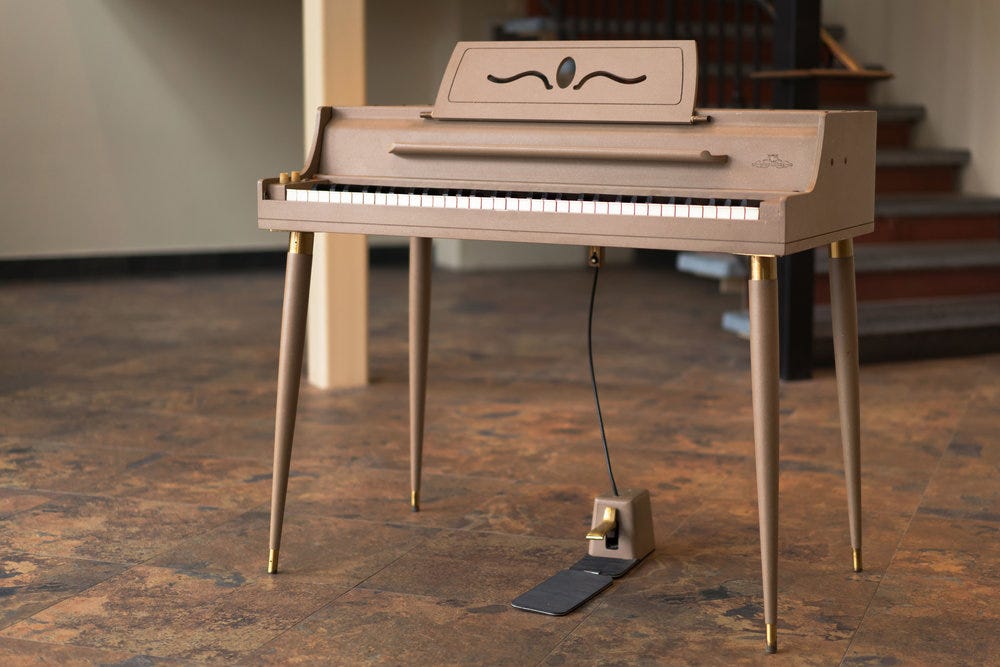Tips on photographing Wurlitzers (and other objects)
Choosing a background for a product photo, using natural light & more

For the last few weeks, we’ve been restoring three Wurlitzers. One of the final steps is taking photos. Photos, of course, are necessary to sell the keyboards—but I think it’s also important to document the keyboards. At this point, 40+ years after production ended, every Wurlitzer is different, and every restoration is different. I’m glad to have a record of the keyboards we’ve worked on.
In the beginning, we’d sometimes snap a quick iPhone photo of the Wurlitzers, and they’d sell before we’d ever have a chance to take real pictures. The perfect 140b below, for instance, sold almost immediately. Jon was about to wheel it out the door and load it into the car when I insisted that we stop and take decent photos of it. We were in the lobby of the building—not the most exciting setting, but the lighting was nice that day. At the time, it was an inconvenience, because we were supposed to be on our way to meet with the buyer. I don’t remember what happened next—maybe we were a couple minutes late to the meeting, maybe not. If we were, there were no bad consequences. The buyer loved the keyboard; we made a profit; we moved on to the next project. But we never did find another 140b in such mint condition, and I’m glad we took a few minutes to snap these photos. If you’ve followed us for a while, you’ve probably seen them before. I use them all the time to illustrate features of the 140b.
Almost a decade later, we put more work into restoring our Wurlitzers, and we want to show that with clear photos. Product photography is extremely technical, and I’m still learning more all the time. Here are a few of my tips for achieving better product shots.
CHOOSING A BACKGROUND
The classic product photo shows the object for sale against a plain white background. I have done similar shots using neutral-colored seamless paper, but I never use stark white backgrounds. I have a few reasons.
First of all, I associate plain white backgrounds with generic, mass-produced items. Amazon, for instance, sells products photographed on a plain white background. Certain luxury products are also photographed against a white background, but I don’t love that either. It introduces an element of unreality. Real things in the real world don’t float in a nebulous expanse of pure white. A Patek Philippe watch on a white background says: what you are seeing is not the watch you buy, but a Platonic ideal of a watch, that perfect copy which all earthly watches spring from. And yet the watch is also there, on a real website, right next to an “Add to Cart” button. The message seems to be that—for the low price of $38,000—you yourself can own the ideal watch.
But Wurlitzers—even our Wurlitzers, although we do our best to make them excellent playable instruments—are not ideal. We’re all about 40 or 70 years too late for that. Every Wurlitzer (even the perfect 140b!) has been scratched, knocked around, spilled on. There’s no hiding the fact that Wurlitzers exist in the real world, and that’s why I prefer to photograph them against real-world backgrounds.
Finally, achieving a flawless white background is a major technical challenge. If you fail to hit the mark, the viewer doesn’t think of sleek modern production lines or Platonic perfection or anything like that. The photo promotes no illusion at all. It just depicts a hazy keyboard with overexposed highlights, blown-out edges and chromatic aberration everywhere. It looks worse than an iPhone photo, even though it probably took all afternoon to capture.
ALTERNATIVES TO WHITE BACKGROUNDS: NEUTRAL SEAMLESS
Seamless paper is a large roll of finely-toothed paper used for photography backgrounds. Unlike kraft paper, mat paper, posterboard, or Home Depot paper dropcloth, seamless has an unobtrusive texture and a high-quality matte finish. It comes in a variety of colors, including an array of neutral grays and beiges. I prefer these colors to white backgrounds.

First of all, objects photographed on gray or beige seamless look more natural. The color of the background affects the color of the highlights. When you photograph an object against a beige or gray background, you can tell by the highlights that the object was actually sitting in this field of neutral color. The background is artificial, but the highlights make the object seem real enough. This is a strategy taken by a lot of newer luxury brands. Even if the photos are not technically perfect, the product is clearly visible and obviously real. That makes it a successful product shot.
In contrast, white backgrounds are intensely reflective, to the point where it’s easy to end up with highlights that are overexposed or hazy at the edges. This makes the object look more like a hallucination than something that you could actually purchase and receive in the mail. I don’t want to call out bad photography, because a lot of it is small businesses trying their best, and it’s usually irrelevant to the quality of the product. But you can see what I’m talking about if you spend five minutes browsing eBay or Ruby Lane.
To eliminate bad highlights, you need a lot of careful flagging (that is, blocking reflections with dark, light-absorbing panels) and intense post-production editing. This is why Patek Philippe watches look almost like an animation. (In fact, there’s a chance that they are literally animation. To avoid the pitfalls and expense of photographing white backgrounds, many product photos are not photos at all, but hyper-realistic 3D renderings.)



